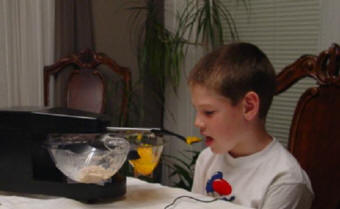I recently found this in the ‘Independent Eating and Drinking Newsletter by Mealtimes Partners, Inc.’
The Use of Prosthetics for Eating
Independent eating is a complicated function involving many parts of the body and a good deal of coordination. Contemplate just what takes place when a cracker is picked up and placed into someone’s mouth. First the eyes have to judge where the cracker is and send a message to the brain to move the hand to the location of the cracker. Once the hand arrives at the location, the brain must instruct the fingers to assume the appropriate positioning to grasp the cracker. The appropriate pressure of the fingers must be included in this instruction set, otherwise the cracker will shatter and all that will be left is crumbs.
Once the cracker is grasped between the fingers and thumb, it must be lifted toward the mouth. This requires more instructions to be sent from the brain to the hand, forearm, wrist, upper arm and shoulder. On arrival at the mouth the cracker must be placed into the mouth and the lips first must open and then close. The teeth or gums must bite a piece of cracker off of the whole cracker and the piece must be chewed and then swallowed (which is another complete set of instructions and another topic which we will not discuss here).
Now revisit this scenario and remove normal hand or arm function, or both. A complicated sequence of events looks impossible without some form of physical aid, or assistive technology. For those with impaired arm and/or hand function, therapists usually try a wide variety of equipment that is commercially available to see if they can provide adequate assistance for the person to begin self-feeding.
However, for those who have missing limbs, the circumstances are very different from those who have malfunctioning limbs. When limbs are missing either a prosthetic must be developed, or some type of adaptive device (a splint or shoulder harness with a utensil attached) that can be mounted on the end of the missing limb/s must be acquired if the individual is going to have any potential for feeding them self. Also, depending upon where the limb ends (above the wrist, above the elbow, etc.) dramatically impacts how an aid, or prosthetic device, can be attached and controlled or operated. Also, if a person is born with a missing limb or limbs, it is a different learning situation from those who have had limbs that have been amputated. Yet, in either case, self-feeding remains a difficult task to master for those with missing limbs.
… At mealtimes, as a stop-gap measure for young children who have missing upper limbs or hands, it is not uncommon to have the child eat food directly off of the tray of their high chair by lowering their mouth to the food. If this method is used, it is recommended that the surface from which they are eating be raised enough that the child does not bend their back and neck all the way down to waist level because this will cause stress on those areas of the body. This method allows a child to develop the concept of independent eating but it should only be temporary as it is too stressful for the long term and will lead to damage to muscles and joints over time. The only thing that is gained from eating in this manner is that it is “independent eating” rather than being fed. This method of eating is used by adults who have congenital upper limb loss, because in earlier generations of people born with missing upper limbs, it was the only way that they could eat independently. However, adults who have lost upper limbs having had functional hands and arms, rarely use this method to eat.
For anyone with missing or poorly functioning or non-functioning hands and/or arms an easy solution to independent eating is a device specifically designed for eating, such as the Mealtime Partner Dining System. Even children as young as three years old can use this type of dining system and can gain the kind of mealtime independence that is normally acquired by children of that age. For everyone who is dependent upon another person at mealtimes, the Mealtime Partner Dining System is an easy solution to feeding themselves.
 |
Imagine sitting down to Thanksgiving Dinner with family and friends and your family member, who last year was fed, eating their meal independently. The Mealtime Partner Dining System empowers its users to be able to feed themselves. No longer must they wait to be fed, instead they can enjoy their meal at the pace they choose, with everyone else. What a wonderful way to celebrate the Thanksgiving feast – together! Click the following link below to learn more about how to gain mealtime independence for those who cannot feed themselves. |
| The Mealtime Partner Dining System is quick and easy to learn and has no complicated programming requirements. Each Dining Systems comes with a complete training video on DVD so new users and caregivers can learn to use it in just a few minutes. To view a list of the instructional videos that may be selected by title, click here. | |
